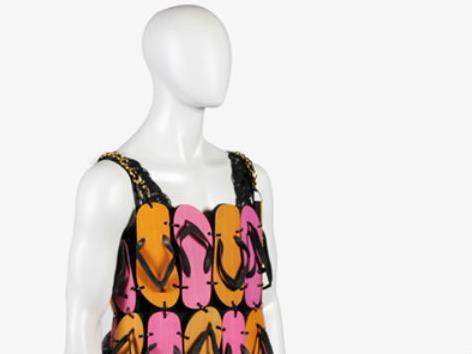Exhibitions no longer display only physical objects – they are filled with audio-visual presentations and interactive displays. So does an exhibition need to exist at all physically?
That is the question that has prompted the National Film and Sound Archive (NFSA) to create its online exhibition celebrating the 20th anniversary of Priscilla: Queen of the Desert.
Like any modern exhibition, Priscilla: 20 Years Young is a collection of words, pictures, video and displayed objects curated to tell a story. Unlike others, it does not exist in any place or time, only online.
So what makes it an exhibition and not just another web page? ‘It’s really a cross between an exhibition and a web page,’ said Curator Tenille Hands. ‘It’s about presenting a curated view. There’s a lot to tackle, there’s 3D capture of the costumes for example. You are able to get in more to have more control, zoom in, interact, move about the space.’
All museums now have online content that supports and promotes their regular exhibitions but the idea of presenting all the content online as an exhibition is new.
Hands said it grew out of a desire to make more out of the celebration of the 20 year anniversary of a much-loved Australian film. ‘We had an event earlier in the year celebrating Priscilla but it was so limited in terms of being geographically isolated and time isolated. It was great within those limitations but we really wanted to be able to do more. It got us thinking about how to get audiences to recognise Priscilla for its creative and technical achievements and how to curate something that would highlight all those different aspects.’
The exhibition has no opening hours, no end date and no cost. Users can ‘pop in’ for 10 minutes and return repeatedly, take a cursory look around or drill down to view a location proof sheet, a Polish promotional poster, or the synopsis from the pitch concluding with the line, ‘The structure is safe. The subject is not.’
Another advantage is the capacity to display fragile items such as the remarkable costumes that could not handle the lighting of a regular exhibition. ‘It allows us to preserve the object but still display it,’ said Hands.
Like any exhibition, Priscilla strives to tell the stories of the subject. The famous thong dress, for example, began life as a credit card dress but failed to get up because no credit card company would provide designer Tim Chappel with the necessary blanks. He then tried the same idea with Vegemite on toast but ‘the flies liked it too much’. So he thought of the archetypal Australian footwear, used his mother’s Target staff discount store card, and for $7 bought the materials for the thong dress.
Another component traces the development of the film’s musical theme, which was originally based around the music of Kylie Minogue but ended up with Abba.
Hands said she was impressed with how much audiences were interested in the backstory of a film, such as the day to day lives of actors on the set or the technical challenges of making a film.
To create the exhibition, the NFSA conducted extensive interviews with key people and then edited them down to help audiences find their way around the material.
‘One of the things we really struggled with is how do we make this different from a blog or a web page? We didn’t want just to have a whole lot of sound bites and dumb down the material. We did the 3D captures, we scanned all the documents and then sorted them so that people don’t have to scroll.
‘We will be really interested to see how audiences engage with the exhibition,’ Hands said.
Ironically the one thing audiences can’t see at the exhibition is the film itself, due to copyright restrictions.
As a curator Hands doesn’t believe online exhibitions will ever completely replace the magic of the object in a traditional museum exhibition but they will bring the opportunities of an exhibition to many more people.





